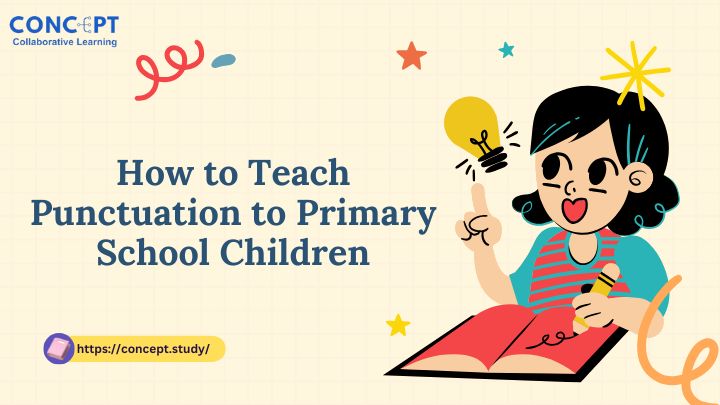
How to Teach Punctuation to Primary School Children
Punctuation is the backbone of written communication. For primary school children, learning to use punctuation properly isn’t just about following grammar rules — it’s about expressing themselves clearly and confidently. This article explores how to teach punctuation to primary school children through engaging, age-appropriate methods that make learning stick.
Why Teaching Punctuation Matters in Primary School
Children are natural storytellers. However, without punctuation, their ideas can quickly become jumbled and unclear. Teaching punctuation early helps pupils:
- Develop better sentence structure
- Improve reading fluency
- Gain confidence in writing
- Understand tone and expression
In the UK National Curriculum, punctuation is introduced as early as Key Stage 1 and built upon in Key Stage 2. Mastering it early gives children a vital head start in literacy. Simple GCSE Biology Guide
Strategy 1: Start with the Basics – Full Stops and Capital Letters
Key Teaching Tips:
- Use short, simple sentences to show the purpose of a full stop.
- Pair it with capital letters to teach how to start a sentence properly.
Classroom Idea:
Write out a paragraph without any punctuation on the board. Ask pupils to add capital letters and full stops in the correct places. Learn Student Guide to Conservation of Energy
Strategy 2: Use Storybooks to Highlight Punctuation in Context
Children love stories — and stories love punctuation. Reading picture books aloud provides an excellent opportunity to draw attention to punctuation marks.
Suggested Books:
- The Day the Crayons Quit by Drew Daywalt – great for exclamation marks and commas.
- Don’t Let the Pigeon Drive the Bus! by Mo Willems – ideal for question marks and expressive punctuation.
Ask pupils: Why do you think the author used an exclamation mark here?
Strategy 3: Make Learning Fun with Punctuation Games
Gamification increases engagement and retention. Try:
- Punctuation Bingo – Call out sentence types; children cover the correct punctuation mark.
- Punctuation Relay – Teams correct unpunctuated sentences on the board in a race.
- Punctuation Sort – Mix up different punctuation marks and have pupils match them to example sentences.
Strategy 4: Visual Aids – Posters and Anchor Charts
Visual reminders help pupils internalise rules. Create punctuation posters with:
- Examples
- Illustrations (e.g. a question mark shaped like a detective)
- Colour-coded marks for easier recall
Place them at eye level around the classroom or in pupils’ writing books. What is a Prime Number?

Strategy 5: Interactive Whiteboard Activities
Use smartboards or tablets to make punctuation lessons interactive. Programmes like Twinkl, Topmarks, and BBC Bitesize have ready-made interactive punctuation activities. Interactive quizzes and drag-and-drop punctuation games allow real-time correction and reinforcement.
Strategy 6: Incorporate Daily Writing Practice
Repetition builds mastery. Use:
- Morning writing journals
- Short writing prompts (e.g., “Describe your dream pet”)
- Sentence-of-the-day corrections
Make punctuation a habit, not a lesson.
Strategy 7: Teach One Punctuation Mark at a Time
Don’t overload pupils. Focus on:
- Full stops
- Capital letters
- Commas in a list
- Question marks
- Exclamation marks
- Apostrophes
Each punctuation mark should be introduced with:
- A clear definition
- Examples
- Practice exercises
Common Punctuation Mistakes and How to Correct Them
| Mistake | Correction | Explanation |
| Using a comma instead of a full stop | Use a full stop to separate complete thoughts | Helps avoid run-on sentences |
| Capital letters mid-sentence | Use only at the start or for proper nouns | Maintains sentence clarity |
| Missing apostrophes | Use apostrophes for possession or contractions | Aids sentence meaning |
Conclusion
Teaching punctuation to primary school children doesn’t have to be dull or daunting. By combining structure with creativity, educators can foster a lifelong love for writing, with punctuation as a trusted companion. Enrol now for affordable Online Tutoring UK
FAQs: Teaching Punctuation in Primary School
1. At what age should punctuation be taught?
Children begin learning basic punctuation (e.g. full stops, capital letters) in Reception and Year 1, expanding to commas and apostrophes by Year 3.
2. How do I help pupils who struggle with punctuation?
Break down concepts into bite-sized lessons, use visual aids, and provide regular one-on-one support or guided writing.
3. Can I use songs or rhymes to teach punctuation?
Absolutely! Rhymes make learning memorable. Try songs like the “Punctuation Rap” on YouTube.
4. What punctuation should Key Stage 2 pupils master?
They should confidently use:
- Full stops
- Commas
- Apostrophes (contractions & possession)
- Speech marks
- Question and exclamation marks
5. How can I assess punctuation understanding?
- Marking rubrics for writing tasks
- Self-editing checklists
- Peer review activities
